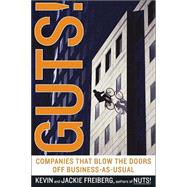
Note: Supplemental materials are not guaranteed with Rental or Used book purchases.
Purchase Benefits
What is included with this book?
| Introduction | p. ix |
| Gutsy Leaders Blow the Doors Off Business as Usual | p. 1 |
| Gutsy Leaders Brand Their Cultures | p. 23 |
| Gutsy Leaders Create a Sense of Ownership | p. 67 |
| Gutsy Leaders Hire People Who Don't Suck | p. 111 |
| Gutsy Leaders Lead with Love | p. 153 |
| Gutsy Leaders Make Business Heroic | p. 199 |
| Gutsy Leaders Inspire Fun | p. 237 |
| Conclusion: Great Leaders Gotta Have Guts! | p. 265 |
| Acknowledgments | p. 268 |
| Index | p. 273 |
| Table of Contents provided by Ingram. All Rights Reserved. |
The New copy of this book will include any supplemental materials advertised. Please check the title of the book to determine if it should include any access cards, study guides, lab manuals, CDs, etc.
The Used, Rental and eBook copies of this book are not guaranteed to include any supplemental materials. Typically, only the book itself is included. This is true even if the title states it includes any access cards, study guides, lab manuals, CDs, etc.
Excerpted from Guts!: Companies That Blow the Doors off Business-as-Usual by Kevin Freiberg, Jackie Freiberg
All rights reserved by the original copyright owners. Excerpts are provided for display purposes only and may not be reproduced, reprinted or distributed without the written permission of the publisher.